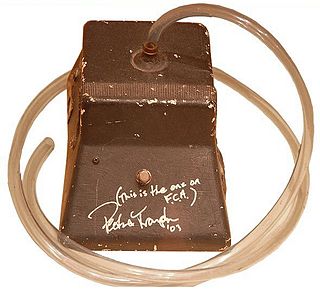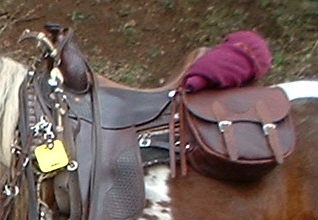
The uterus or womb is the organ in the reproductive system of most female mammals, including humans, that accommodates the embryonic and fetal development of one or more embryos until birth. The uterus is a hormone-responsive sex organ that contains glands in its lining that secrete uterine milk for embryonic nourishment.
Countercurrent exchange is a mechanism occurring in nature and mimicked in industry and engineering, in which there is a crossover of some property, usually heat or some chemical, between two flowing bodies flowing in opposite directions to each other. The flowing bodies can be liquids, gases, or even solid powders, or any combination of those. For example, in a distillation column, the vapors bubble up through the downward flowing liquid while exchanging both heat and mass.

In medicine, venipuncture or venepuncture is the process of obtaining intravenous access for the purpose of venous blood sampling or intravenous therapy. In healthcare, this procedure is performed by medical laboratory scientists, medical practitioners, some EMTs, paramedics, phlebotomists, dialysis technicians, and other nursing staff. In veterinary medicine, the procedure is performed by veterinarians and veterinary technicians.

A vacutainer blood collection tube is a sterile glass or plastic test tube with a colored rubber stopper creating a vacuum seal inside of the tube, facilitating the drawing of a predetermined volume of liquid. Vacutainer tubes may contain additives designed to stabilize and preserve the specimen prior to analytical testing. Tubes are available with a safety-engineered stopper, with a variety of labeling options and draw volumes. The color of the top indicates the additives in the vial.

In urinary catheterization a latex, polyurethane, or silicone tube known as a urinary catheter is inserted into the bladder through the urethra to allow urine to drain from the bladder for collection. It may also be used to inject liquids used for treatment or diagnosis of bladder conditions. A clinician, often a nurse, usually performs the procedure, but self-catheterization is also possible. A catheter may be in place for long periods of time or removed after each use.
A blood bank is a center where blood gathered as a result of blood donation is stored and preserved for later use in blood transfusion. The term "blood bank" typically refers to a department of a hospital usually within a Clinical Pathology laboratory where the storage of blood product occurs and where pre-transfusion and Blood compatibility testing is performed. However, it sometimes refers to a collection center, and some hospitals also perform collection. Blood banking includes tasks related to blood collection, processing, testing, separation, and storage.

Respiratory arrest is a serious medical condition caused by apnea or respiratory dysfunction severe enough that it will not sustain the body. Prolonged apnea refers to a patient who has stopped breathing for a long period of time. If the heart muscle contraction is intact, the condition is known as respiratory arrest. An abrupt stop of pulmonary gas exchange lasting for more than five minutes may permanently damage vital organs, especially the brain. Lack of oxygen to the brain causes loss of consciousness. Brain injury is likely if respiratory arrest goes untreated for more than three minutes, and death is almost certain if more than five minutes.

A wire stripper is a small, hand-held device used to strip the electrical insulation from electric wires.

A talk box is an effects unit that allows musicians to modify the sound of a musical instrument by shaping the frequency content of the sound and to apply speech sounds onto the sounds of the instrument. Typically, a talk box directs sound from the instrument into the musician's mouth by means of a plastic tube adjacent to a vocal microphone. The musician controls the modification of the instrument's sound by changing the shape of the mouth, "vocalizing" the instrument's output into a microphone.

A bag valve mask (BVM), sometimes known by the proprietary name Ambu bag or generically as a manual resuscitator or "self-inflating bag", is a hand-held device commonly used to provide positive pressure ventilation to patients who are not breathing or not breathing adequately. The device is a required part of resuscitation kits for trained professionals in out-of-hospital settings (such as ambulance crews) and is also frequently used in hospitals as part of standard equipment found on a crash cart, in emergency rooms or other critical care settings. Underscoring the frequency and prominence of BVM use in the United States, the American Heart Association (AHA) Guidelines for Cardiopulmonary Resuscitation and Emergency Cardiac Care recommend that "all healthcare providers should be familiar with the use of the bag-mask device." Manual resuscitators are also used within the hospital for temporary ventilation of patients dependent on mechanical ventilators when the mechanical ventilator needs to be examined for possible malfunction or when ventilator-dependent patients are transported within the hospital. Two principal types of manual resuscitators exist; one version is self-filling with air, although additional oxygen (O2) can be added but is not necessary for the device to function. The other principal type of manual resuscitator (flow-inflation) is heavily used in non-emergency applications in the operating room to ventilate patients during anesthesia induction and recovery.
Cord blood is blood that remains in the placenta and in the attached umbilical cord after childbirth. Cord blood is collected because it contains stem cells, which can be used to treat hematopoietic and genetic disorders such as cancer. There is growing interest from cell therapeutics companies in developing genetically modified allogenic natural killer cells from umbilical cord blood as an alternative to CAR T cell therapies for rare diseases.

An infusion pump infuses fluids, medication or nutrients into a patient's circulatory system. It is generally used intravenously, although subcutaneous, arterial and epidural infusions are occasionally used.

A dust collector is a system used to enhance the quality of air released from industrial and commercial processes by collecting dust and other impurities from air or gas. Designed to handle high-volume dust loads, a dust collector system consists of a blower, dust filter, a filter-cleaning system, and a dust receptacle or dust removal system. It is distinguished from air purifiers, which use disposable filters to remove dust.

Saddlebags are bags that are attached to saddles.

A surgical drain is a tube used to remove pus, blood or other fluids from a wound, body cavity, or organ. They are commonly placed by surgeons or interventional radiologists after procedures or some types of injuries, but they can also be used as an intervention for decompression. There are several types of drains, and selection of which to use often depends on the placement site and how long the drain is needed.

A space toilet or zero-gravity toilet is a toilet that can be used in a weightless environment. In the absence of weight, the collection and retention of liquid and solid waste is directed by use of airflow. Since the air used to direct the waste is returned to the cabin, it is filtered beforehand to control odor and cleanse bacteria. In older systems, wastewater is vented into space, and any solids are compressed and stored for removal upon landing. More modern systems expose solid waste to vacuum pressures to kill bacteria, which prevents odor problems and kills pathogens.
A urine collection device or UCD is a device that allows the collection of urine for analysis or for purposes of simple elimination. UCDs of the latter type are sometimes called piddle packs.

A ureterostomy is the creation of a stoma for a ureter or kidney.

Manual fare collection is the practice of collecting fares manually. "Fare collection" generally refers to the collection of fares in the transport industry in return for a ticket or passes to travel. Commonly used on buses and train transport systems, manual fare collection is increasingly becoming obsolete with the introduction of smart cards such as the Transport for London 'Oyster card'. However, in the face of this trend, some companies have opted to retain more traditional methods of manual fare collection to both save money and ensure reliability. In the United Kingdom, examples of this can be seen on the Transport for London Heritage lines and the FirstGroup FTR routes in York, Leeds, Luton, and Swansea where bus conductors have returned to work. The other reason(with lowering prices of electronics, and in most cases need to buy it once) may be for Heritage routes - tradition "look", for other routes(because of quite high monthly labor cost in UK) agreements and strong unions with the tries from politics to lower the unemployment rate by making overworking in public service.

A medical bag is a portable bag used by a physician or other medical professional to transport medical supplies and medicine.
















